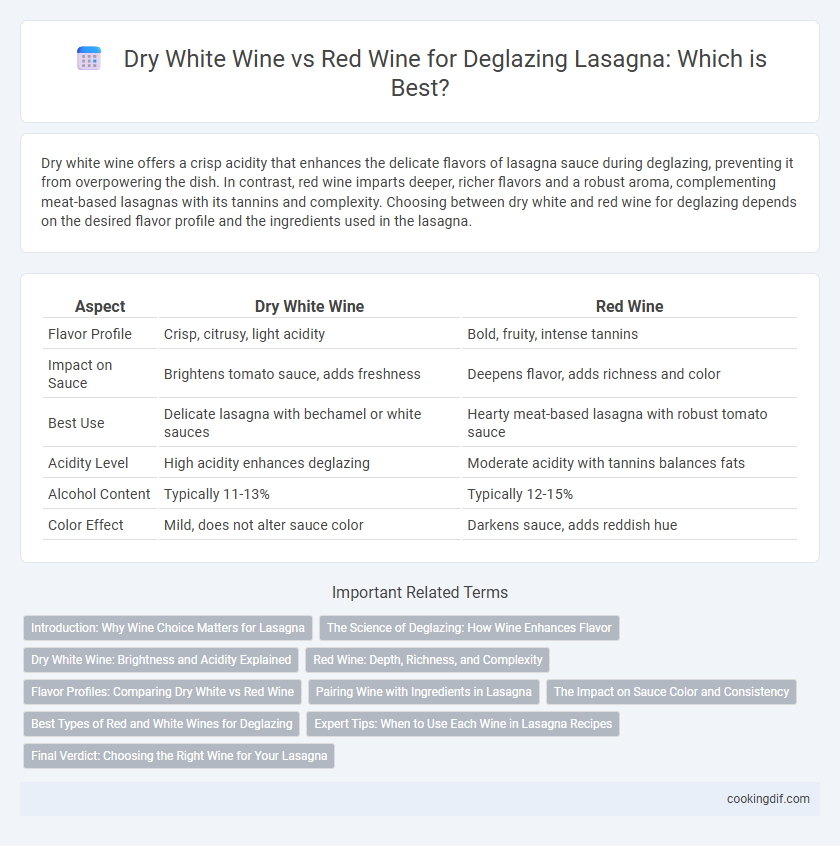Dry white wine offers a crisp acidity that enhances the delicate flavors of lasagna sauce during deglazing, preventing it from overpowering the dish. In contrast, red wine imparts deeper, richer flavors and a robust aroma, complementing meat-based lasagnas with its tannins and complexity. Choosing between dry white and red wine for deglazing depends on the desired flavor profile and the ingredients used in the lasagna.
Table of Comparison
| Aspect | Dry White Wine | Red Wine |
|---|---|---|
| Flavor Profile | Crisp, citrusy, light acidity | Bold, fruity, intense tannins |
| Impact on Sauce | Brightens tomato sauce, adds freshness | Deepens flavor, adds richness and color |
| Best Use | Delicate lasagna with bechamel or white sauces | Hearty meat-based lasagna with robust tomato sauce |
| Acidity Level | High acidity enhances deglazing | Moderate acidity with tannins balances fats |
| Alcohol Content | Typically 11-13% | Typically 12-15% |
| Color Effect | Mild, does not alter sauce color | Darkens sauce, adds reddish hue |
Introduction: Why Wine Choice Matters for Lasagna
Choosing the right wine for deglazing impacts the depth of flavor in lasagna, with dry white wine offering a crisp acidity that brightens tomato sauces and balances the richness of bechamel. Red wine provides robust tannins and fruity notes, enhancing the meatiness and complexity of the ragu. Understanding these differences allows chefs to tailor the sauce's profile, elevating the overall taste and harmony of traditional Italian lasagna.
The Science of Deglazing: How Wine Enhances Flavor
Dry white wine's higher acidity and lighter tannins efficiently lift browned fond from pans, promoting a bright, crisp flavor profile that enhances lasagna sauces without overpowering. Red wine, rich in tannins and deeper color compounds, contributes robust, complex flavors but may darken the sauce and require longer reduction times to mellow bitterness. Understanding the phenolic content and acidity levels in wines ensures precise deglazing choices that elevate the depth and balance of lasagna's savory layers.
Dry White Wine: Brightness and Acidity Explained
Dry white wine enhances lasagna preparation by adding brightness and acidity that balance rich, creamy layers and hearty tomato sauce. Its crisp acidity lifts the flavors without overpowering, creating a harmonious blend with the bechamel or ricotta cheese. Using dry white wine for deglazing releases subtle fruity and citrus notes, which intensify the complexity of the filling and improve overall flavor depth.
Red Wine: Depth, Richness, and Complexity
Red wine, with its robust tannins and bold flavor profile, enhances lasagna by adding depth, richness, and complex fruity and earthy notes during deglazing. It intensifies the meat sauce, balancing acidity and sweetness while infusing vibrant color and texture. Using dry red wine like Chianti or Merlot elevates the overall savory experience, creating a more layered and satisfying dish.
Flavor Profiles: Comparing Dry White vs Red Wine
Dry white wine imparts a light, crisp acidity with subtle fruity and floral notes, enhancing the delicate layers of a lasagna without overpowering its flavors. Red wine offers richer, deeper tannins and bold berry or plum undertones, adding complexity and intensity to meat-based sauces. Choosing between dry white and red wine for deglazing depends on the desired flavor balance, with white wine complementing creamy bechamel and red wine enriching tomato sauces and hearty ragu.
Pairing Wine with Ingredients in Lasagna
Dry white wine, such as Pinot Grigio or Sauvignon Blanc, is ideal for deglazing when preparing white sauce in lasagna, as its crisp acidity complements creamy bechamel and mild cheeses like ricotta. Red wine, like Chianti or Sangiovese, enhances meaty ragu layers with its robust tannins and fruity depth, harmonizing with tomato-based sauces and ground beef or sausage. Choosing the wine that matches the dominant lasagna ingredient improves flavor integration and elevates the dish's overall complexity.
The Impact on Sauce Color and Consistency
Using dry white wine for deglazing in lasagna sauce results in a lighter color and a more delicate, slightly tangy flavor that enhances the sauce's brightness without overpowering other ingredients. Red wine contributes a deeper, richer hue and a robust, full-bodied taste, which intensifies the sauce's complexity and adds a velvety consistency. The choice between white and red wine directly influences the visual appeal and mouthfeel of the sauce, aligning with either a lighter or heartier lasagna style.
Best Types of Red and White Wines for Deglazing
Dry white wines such as Sauvignon Blanc and Pinot Grigio are ideal for deglazing lasagna pans due to their crisp acidity and subtle fruitiness, which enhance the sauce without overwhelming the dish. In contrast, full-bodied red wines like Chianti and Sangiovese contribute rich tannins and deep berry flavors, complementing the savory meat layers and tomato base. Choosing between these wines depends on the lasagna's flavor profile, with white wines providing brightness and red wines adding robust depth.
Expert Tips: When to Use Each Wine in Lasagna Recipes
Dry white wine enhances lasagna by adding subtle acidity and brightening tomato-based sauces without overpowering other ingredients, ideal for recipes with lighter cheeses or seafood additions. Red wine, rich in tannins and robust flavors, deepens the sauce complexity and complements meat-heavy lasagna such as those with ground beef or sausage. Expert chefs recommend using dry white wine for delicate or cream-based lasagnas, while red wine suits traditional meat sauces, ensuring balanced flavor development during deglazing.
Final Verdict: Choosing the Right Wine for Your Lasagna
Dry white wine offers a crisp acidity that enhances lighter lasagna fillings with vegetables or seafood, while red wine's robust tannins complement rich meat sauces and tomato-based recipes. Selecting the right wine for deglazing depends on the flavor profile you want to amplify: use dry white wine for brightness and subtlety, and red wine for depth and intensity. For classic meat lasagna, a medium-bodied red like Chianti works best, whereas a dry white such as Pinot Grigio suits creamy or vegetable lasagnas.
Dry white wine vs Red wine for deglazing Infographic

 cookingdif.com
cookingdif.com